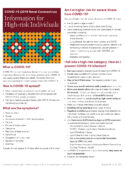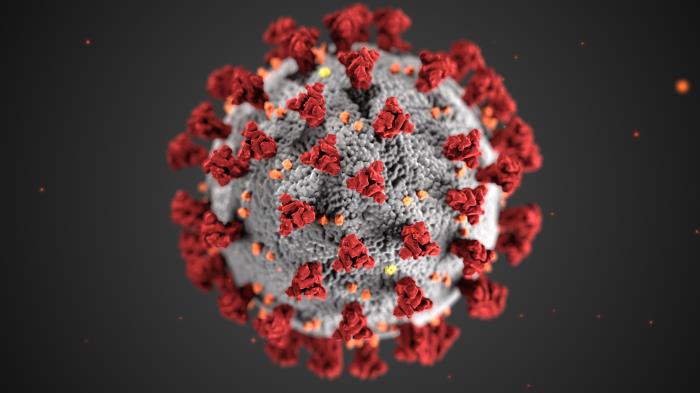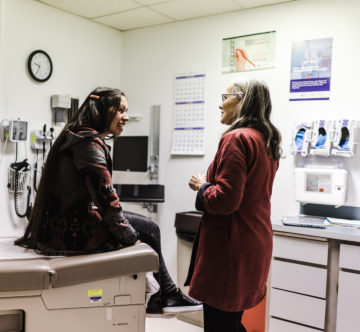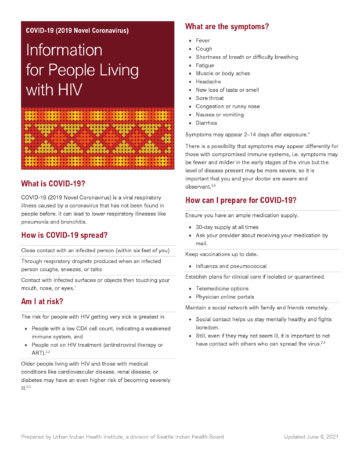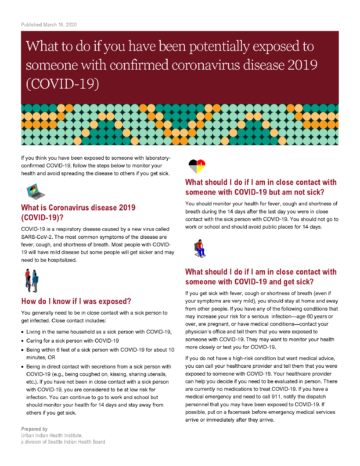Updated: Mar 18, 2020
Learn how to protect yourself if you are at a higher risk of contracting COVID-19.
Updated March 30, 2021
View All COVID-19 Resources for Tribes and Urban Indian Communities
Contents
What is COVID-19 (Novel Coronavirus)?
COVID-19 (Novel Coronavirus Disease 2019) is a viral respiratory illness caused by a coronavirus that has not been found in people before. It can lead to lower respiratory illnesses like pneumonia and bronchitis.
How is COVID-19 spread?
- Close contact with an infected person (within 6 feet)
- Through respiratory droplets produced when an infected person coughs or sneezes
- Contact with infected surfaces or objects then touching your mouth, nose, or eyes1
What are the symptoms?
- Fever
- Cough
- Shortness of breath
Symptoms may appear 2–14 days after exposure.
Currently, there is no vaccine to prevent COVID-19.
Am I at higher risk of contracting COVID-19?
People who fall under one of the categories below have a higher risk of getting sick from COVID-19.
- Older adults and elders (people 60 years of age and older)
- People who have been diagnosed with chronic medical conditions like:
- Heart Disease including hypertension2 and coronary heart disease
- Lung Disease like asthma, emphysema, and COPD
- Cancer patients like people with Hematologic [blood] Malignancies, people in active chemotherapy, and bone marrow transplant patients3
- Diabetes
- HIV/AIDS
- Other immunocompromising conditions
I fall into a high-risk category. How do I prevent COVID-19 infection?
- Avoid close contact with people who are sick.
- Wash your hands often with soap and water for at least 20 seconds—if soap and water are not available, use a hand sanitizer that contains at least 60% alcohol.
- Avoid sharing household items like dishes, drinking glasses, towels, or bedding.
- Whenever possible, avoid touching high-touch surfaces – i.e. door handles, handrails, countertops.
- Avoid shaking hands.
Wash your hands after being in public places.
Avoid touching your face (nose, eyes, mouth in particular). - Regularly disinfect your home, paying close attention to high- touch surfaces – i.e. doorknobs, light switches, desks, cell phones, and countertops.
- Use Environmental Protection Agency (EPA) approved household disinfectants. Some examples include:
- Clorox Multi Surface Cleaner + Bleach
PURELL Professional Surface Disinfectant Wipes o Lysol Disinfectant Spray
Lysol Clean & Fresh Multi-Surface Cleaner - For a comprehensive Environmental Protection Agency (EPA) list, visit americanchemistry.com/Novel-Coronavirus-Fighting-Products-List.pdf
- Clorox Multi Surface Cleaner + Bleach
- Avoid large crowds (10+ people), especially in poorly ventilated spaces.
- If COVID-19 is spreading in your community, stay home as much as possible.
- Avoid all non-essential travel.
I fall into a high-risk category. How do I prepare for a COVID-19 outbreak?
- Prepare yourself, your household and your community for an outbreak.
- Have the necessary supplies on hand.
- Contact your healthcare provider (psychiatrist, pharmacist, physician) to ask about obtaining extra necessary medications and other health guidance. Having extra medication can help you avoid spending time away from home during an outbreak in your community.
- Consider mail-ordering your medications.
- Have over-the-counter medicines and supplies to treatfever and other symptoms of COVID-19.
- Aspirin (acetylsalicylic acid), Tylenol (acetaminophen), Aleve (naproxen) etc.
- Have enough household items and groceries on hand to stay at home for a prolonged period-of-time or have a plan with your family and community to ensure you will get the supplies you need without having to leave your home.
- Make a plan you can follow if there is an outbreak in your community.
- Consider who needs to be included in your plan.
- Identify aid organizations in your community to contact in case you need support or resources.
- Create an emergency contact list.
- Consider including family, friends, neighbors, carpool drivers, health care providers (physician, nurse, doctor), teachers, employers, etc.
- If you live alone, stay in touch with others by phone, text, or email.
- Consider who needs to be included in your plan.
- Have the necessary supplies on hand.
I fall into a high-risk category and I am starting to experience symptoms. What do I do?
- Monitor your symptoms.
- Write down any symptoms you may be having.
- Record your temperature and write it down. Make sure to record your temperature BEFORE taking any medications that can lower your body temperature.
- Call 911 immediately if you begin to experience any emergency symptoms such as
- Difficulty breathing or shortness of breath
- Persistent pain or pressure in your chest
- New confusion or inability to arouse
- Bluish lips, face, or fingertips
- Remember, this list does not include all emergency warnings. Consult with your medical provider for any other symptoms that may be concerning for you.
- Put on a facemask that covers your nose and mouth before you enter any facility or emergency vehicle.
- Write down any symptoms you may be having.
- Stay home except to get medical care.
- Separate yourself from other people and animals in yourhome.
- Wear a facemask when around other people.
- Take care of your emotional health.
- Outbreaks and sickness can be stressful.
- Stay in touch with your loved ones.
References:
- How COVID-19 Spreads. (2020, February 28). Retrieved March 3, 2020 from https://www.cdc.gov/coronavirus/2019-ncov/about/transmission.html
- Zhou F, Yu T, Du R, et al. Clinical course and risk factors for mortality of adult inpatients with COVID-19 in Wuhan, China: a retrospective cohort study. The Lancet. March 2020. doi:10.1016/s0140-6736(20)30566-3
- Coronavirus: what cancer patients need to know. Fred Hutch. https://www.fredhutch.org/en/news/center-news/2020/03/coronavirus-what-cancer-patients-need-to-know.html. Published March 6, 2020. Accessed March 16, 2020.
All other information from:
- CDC. Get Your Household Ready for Coronavirus Disease 2019. Centers for Disease Control and Prevention. https://www.cdc.gov/coronavirus/2019-ncov/prepare/get-your-household-ready-for-COVID-19.html.
- Published February 11, 2020. Accessed March 16, 2020.CDC. If You Are at Higher Risk. Centers for Disease Control and Prevention. https://www.cdc.gov/coronavirus/2019-ncov/specific-groups/high-risk-complications.html. Published February 11, 2020. Accessed March 16, 2020.CDC. What To Do if You Are Sick. Centers for Disease Control and Prevention. https://www.cdc.gov/coronavirus/2019-ncov/if-you-are-sick/steps-when-sick.html. Published February 11, 2020. Accessed March 16, 2020.Wa.gov.
- https://www.doh.wa.gov/Emergencies/Coronavirus. Published 2020. Accessed March 16, 2020.Wa.gov. https://www.doh.wa.gov/Emergencies/NovelCoronavirusOutbreak2020/HigherRiskforSeriousIllness. Published 2020. Accessed March 16, 2020.

